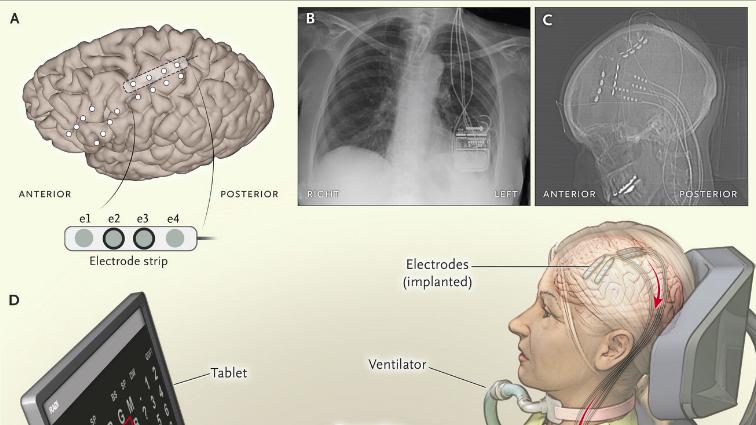brainimplant
Latest

Brain implants help nervous mice find their competitive side
Social competition and establishing dominance are a part of the culture of many species, from humans to mice. That's why the results of a recent study published in Science are so interesting. A team of Chinese scientists changed the behavior of mice to turn "loser" mice into "winners."

Brain implant helps a paralyzed woman communicate at home
A 58-year-old woman left paralyzed by amyotrophic lateral sclerosis (ALS, also known as Lou Gehrig's disease) has now become the first patient to use a brain-computer interface to restore some of her day-to-day functions. The woman was left "almost completely locked-in" after the disease caused her motor neurons to deteriorate to the point where she could only control her eye muscles. While brain implants have been in development for years, this particular patient has become the first to make use of one at home and outside of a research or hospital setting.

Nanowire technology will improve brain-stimulating implants
Scientists at Lund University have published a paper about a new nanowire thread (only 80 nanometres in diameter) that will work to strengthen brain implants. Neuro-prostheses are currently used to stimulate and collect information from the brain of those with Parkinson's disease, along with other illnesses. However, one of the biggest problems that current tech faces is that the brain identifies the implant as a foreign object and uses cellular material to surround the electrode, resulting in a loss of signal. With the newly developed technology, this will (hopefully) no longer be the case.

Brain implants help the paralyzed type faster
It's possible for paralysis victims to type and otherwise communicate with the world, but they usually have to do so at a glacial pace. They might not be nearly so limited in the future, though. In experiments combining BrainGate2 (a high-speed neural implant system) with text entry software, researchers had a Lou Gehrig's sufferer type words at six words per minute. While that may not sound quick on the surface, it's incredibly fast for someone relying solely on mental activity to write a message.

Tiny brain implant delivers drugs with a remote control
An implant, the size of a human hair, can deliver drugs to the brain with the click of a button. A team of researchers from Washington University in St. Louis and the University of Illinois have demonstrated the wireless technology in mice. While a previous iteration of the device delivered LED to neurons that respond to light, the latest experiment successfully introduced pharmacological agents directly to the brain. A drug was first sent to one side of the brain that made a mouse move around in a circle. Next, shining a light onto cells that cue the release of dopamine rewarded the mice with happy feelings. When the rodents came around for more, the researchers used a remote control to interject with a drug that put a halt on the dopamine effect.

The US military wants brain implants to treat combat trauma
For soldiers coping with brain injuries and post-traumatic stress, coming home may be tougher than the actual fighting; their conditions can last a lifetime. Long-term relief may be on the horizon for US veterans, though. DARPA is supporting the White House's brain mapping initiative by funding the development of implants (conceptualized below) that alleviate the symptoms of warriors' mental problems, ranging from PTSD to extreme depression. The technology, built by Massachusetts General Hospital, Draper Laboratory and UC San Francisco, will use sensors to watch for unusual neural activity at multiple parts of the brain. If something's wrong, the implants will use deep electrical stimulation to restore healthy activity -- permanently, if possible.

Mind-operated robot arm helps paralyzed woman have her cup o' joe (video)
Researchers at the Braingate2 consortium have made a breakthrough that allows people with spinal cord or stroke injuries to control robotic limbs with their minds. The original project allowed subjects with motor cortex-implanted chips to move cursors on a screen with their minds, but they can now command DEKA and DLR mechanical arms to grasp foam balls and sip coffee. Researchers noted that dropped objects and missed drinks were frequent, but improved brain sensors and more practice by subjects should help. To see the power of the mind move perhaps not mountains, but good ol' java, jump to the video below.

BioBolt brain implant could help the paralyzed walk again
Controlling a cursor with your brain? Yawn. Restoring movement to paralyzed mice? Color us unimpressed. Help a wheelchair-bound man walk again using only his thoughts? Now we're talking. That's the goal of researchers at the University of Michigan who have developed BioBolt, a (comparatively) noninvasive implant that rests on top of the cortex rather than penetrate it. The device is inserted through an easily-covered, dime-sized hole in the skull and feeds patterns from firing neurons to a computer using your epidermis (which is showing, by the way) as a conductor. The ultimate goal of helping the paralyzed walk again is still years away but, in the meantime, it could be used to suppress seizures or diagnose diseases like Parkinson's. Everyday this mind over matter thing sounds a little less like a load of bullpuckey.

Scientists develop implants that melt onto the surface of the brain
Looks like brain implants have just got a lot more effective -- and a lot creepier. Developed by researchers at the University of Pennsylvania School of Medicine in Philadelphia, the new bio-integrated electronics eschew electrodes resembling needles or semi-flexible wires for an ultrathin flexible material that is made partly from silk. Since the new material "essentially melts into place" (scientists compare it to shrink-wrap), it hugs the brain, getting more effective readings than previous technology. It is hoped that the new technology will prove much more effective -- and extremely beneficial for patients with epilepsy, spinal cord injuries, and other neurological disorders. According to John Rogers, Ph.D., the man who invented the flexible electronics at the University of Illinois, "It may also be possible to compress the silk-based implants and deliver them to the brain, through a catheter." We wish these good folks the best of luck with their research -- and we really, really hope that we never have anything shot into our brain with a catheter. PR after the break.





